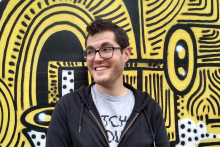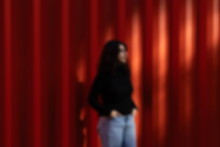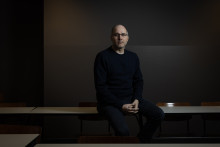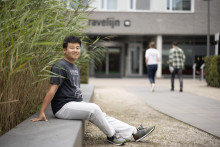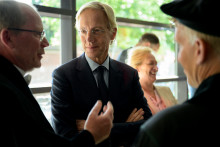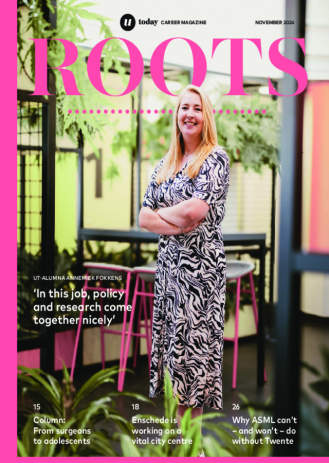What drew you to the UT, Jonathan?
‘One of the things I knew about the UT for years was the high tech, human touch slogan, and the reputation for human-centered technology, which did strike a chord. Already from the very beginning of planning the residency, when I talked with the then-chairman of the Art Committee, Peter-Paul Verbeek, I had the impression that the UT would be a place where my interdisciplinary artistic approach would be welcomed. It’s the combination of rigorous tech research with strong humanistic and ethical considerations that makes this a very interesting place to work as an artist.’
Do these kinds of themes also come into play in your work?
‘I would say so, yes. I’ve always operated at the intersection of art, culture and technology and a lot of my work tries to take an idiosyncratic position on technologies while still being playful and sensorial. It’s not just about creating something that raises provocative questions, or something that tickles the senses, but creating something complex and multilayered that is also accessible. What I really find interesting in that regard is the stories we tell each other about technology. For instance, I’ve contributed to a work called The Intimate Earthquake Archive, which translates all the earthquake data that’s been collected and stored in the archive of the KNMI… The data itself is very meaningful to seismologists, they have a set of stories that are told through science and experience, but it is still only one story of many. When you translate that data into an artwork that people can wear – a vest that vibrates seismic waves across your body, you’re telling people an entirely different story.’
'As an artist, I also look at topics UT researchers are working on from a different perspective'
How are you giving shape to your residency here?
‘The Campus Arts Committee has given me a lot of freedom to shape the residency, which has been amazing, but also an involved process of discovering what my artistic approach and the UT have to offer each other. I think one development that made a lot of sense was to treat this as a research residency rather than a production residency. Most artistic residencies focus on production – creating a new work. A research residency is different in that the emphasis is on discovering new artistic techniques and doing experiments that will lead to new work in the future. The UT has a lot of great communities to learn from and with, and so this approach made a lot of sense to me as a way of creating a meaningful exchange with the UT – doing experiments, meeting with different people and discussing ideas, being embedded in the HMI offices, the DesignLab or the Vrijhof. It also puts me in a position similar to a lot of the researchers on campus. I’m asking artistic questions I don’t know the answer to, and experimenting to find the ‘answers’.’
What do you bring to the table for the academics here?
‘I’ve got a strong skillset in creating artistic works involving digital technologies. I can write software. I can build electronics. I can make interactive music systems. All of these skillsets overlap with many of the things researchers are doing on campus. So I can almost speak the same language and really become something like a temporary peer in the community. As an artist, I also look at topics UT researchers are working on from a different perspective. And I can ask questions that are more radical. After all, I don’t have to write a peer-reviewed paper, my goal is to create provocative art experiences.
So far I’ve been primarily working in collaboration with researchers from the Human Media Interaction research group, and the coming semester I’ll be more integrated at the DesignLab. Edwin Dertien, a brilliant and creative roboticist, has been a fantastic collaborator so far. And also speech technology researcher Khiet Truong. Soon I’ll also be working with Angelika Mader on wearable sensor skins. There’s just a lot of wonderful, generous and talented researchers who are excited about working on more arts-oriented projects. I’ve also been part of borrels, presentations and discussions about AI ethics.’
'Students dig so much deeper into questions than I would be able to'
How do you collaborate with students?
‘One of the most extraordinary aspects of this residency is the interaction with UT students. I’m currently co-supervising three students’ projects, which are connected to themes I’ve proposed as part of the larger artistic questions of the residency. One student is doing perceptual research into masks that distort the sense of facial identity, another is developing a wearable interface for a performing artist to control robotic masks and one who is researching how choral singers can work with artificial intelligence. It’s really exciting to work with students and they all have a background in either culture or craft making. I think it’s a unique opportunity for them as well, considering that the usual graduation projects aren’t arts-based.’
Are their projects all part of a bigger picture, something you’re working towards?
‘Definitely. And the results of their work have a big impact on where the trajectory of the residency goes, which is also an exciting part of this process. They dig so much deeper into questions than I would be able to, and often come up with things I would never think of. And it’s productive to be able to think about how to turn their focused research into something that can be artistically experimented with. For example, we just did a one-day workshop with a bunch of invited artists experimenting with making soft-robotic masks based on the research project of identity-distorting masks.
Generally though, I expect the experiments coming out of this residency to be part of a long artistic trajectory that will result in many works over the coming years. Right now we’re exploring and planting seeds. But if there is a larger picture, I think it has to do with how to blur the perception of fixed human identities – using media such as wearable robotics and artificial voice. Ilse, one of the students I’m co-supervising, is working on the choir and artificial intelligence project, she is also part of vocal group Musilon. She is focusing on the phenomenon of ‘blend’, where many voices become one, and we had a great conversation about her experience being part of the choir – constantly adjusting to the singers around her, always listening. It’s an incredible dynamic complex system that entangles people together through voice. She called it a ‘superorganism’. I think this phenomenon is what I’m most interested in – making performance work, such as opera or participatory performances, where the boundaries between self and other, human and non-human, become uncertain.’
'My main goal for the year is to get creative people together to experiment'
Which we’ll be able to see on campus?
‘I think we’ll definitely do some more workshops connected to student projects, which will be open to the public either at Vrijhof or the DesignLab, so anyone at the UT with an interest in performance and technology can attend. Possibly a pressure cooker workshop near the end of the year to create and assemble elements we have developed like robotic prosthetics and interactive AI voices. Depending on where things are at, we might do either a public presentation or a small exhibition. In the end, my main goal for the year is to get creative people together to experiment and play with the possibilities for these technologies to create unique artistic experiences, not so much to make a finished product.’


